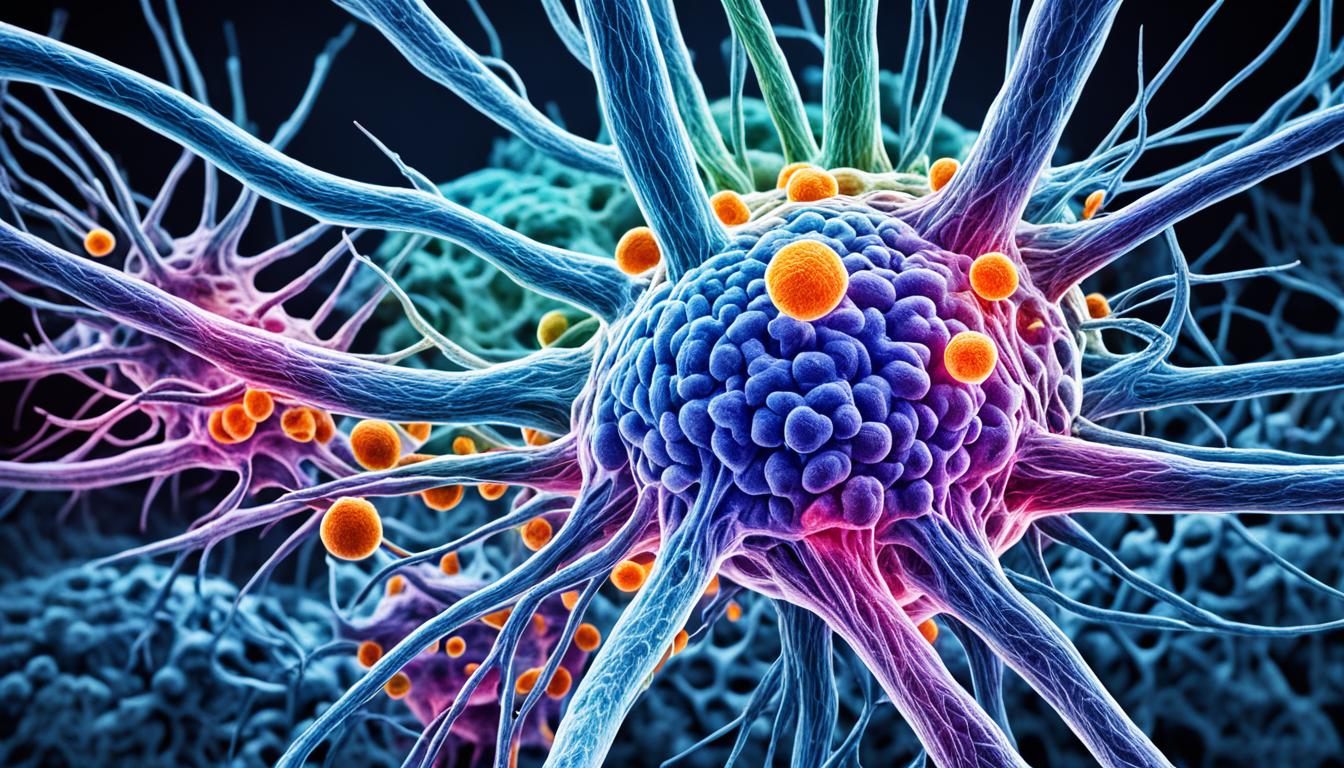Neurofibroma is a genetic disorder group that leads to nerve tissue tumors. It’s called neurofibromatosis and has three types: NF1, NF2, and schwannomatosis. Kids mainly get NF1, while NF2 and schwannomatosis affect adults.
The symptoms of neurofibromatosis change by type. They often show as light brown skin spots, freckling in certain areas, and lumps or bumps under the skin. Other signs may include bone issues, eye nerve tumors, and learning problems. In rare cases, the tumors might turn into cancer.
For treating neurofibromatosis, options include surgery and medications for pain. There are also new therapies like stem cell therapy.
Key Takeaways:
- Neurofibromatosis causes nerve tissue tumors.
- It comes in three types: NF1, NF2, and schwannomatosis.
- Signs can be skin spots, freckles, bone issues, eye nerve tumors, and learning problems.
- Treatment includes surgery, pain drugs, and new methods such as stem cell therapy.
Neurofibromatosis 1 (NF1)
Neurofibromatosis 1 (NF1) is the leading type of neurofibromatosis. It often shows up in childhood. This genetic condition brings various symptoms, and they differ in how severe they are. People with NF1 usually have light brown spots on their skin, known as cafe au lait spots. They might also have freckles in the armpits or groin.
Some signs of NF1 are tiny bumps on the eye’s iris, called Lisch nodules. Others include soft bumps under the skin, known as neurofibromas. These bumps are usually not cancerous, but they can be in a few cases.
People with NF1 might have bone issues, optic gliomas (tumors on the optic nerve), and learning difficulties. They might also have a larger than normal head and be shorter in stature. It’s key to remember that not everyone with NF1 will have all these problems.
Also, NF1 can lead to seizures, vision issues, and heart and lung troubles. It can make coping with hormonal changes harder and increase cancer risks. Even with these challenges, treatment aims to help with specific symptoms and watching for problems early.
No cure for NF1 exists yet. But, managing symptoms and regular check-ups are important. Scientists are also looking into new treatments like stem cell therapy. This brings hope for better ways to handle NF1 in the future.
Symptoms of Neurofibromatosis 1 (NF1)
- Cafe au lait spots: Flat, light brown spots on the skin.
- Freckling: Often found in the armpits or groin area.
- Lisch nodules: Tiny bumps on the iris of the eye.
- Neurofibromas: Soft, pea-sized bumps on or under the skin.
- Bone deformities: Abnormalities in bone structure.
- Optic gliomas: Tumors on the optic nerve.
- Learning disabilities: Challenges with cognitive development and educational attainment.
- Larger head size: Increased circumference of the head compared to typical measurements.
- Short stature: Below-average height.
Neurofibromatosis 2 (NF2)
Neurofibromatosis 2 (NF2) is a rare type of condition. It causes benign tumors on the brain and spine nerves. This disease is not common in children. It’s usually found in teens or young adults. The first sign of NF2 is trouble hearing. This issue can make life hard and affect how people talk. The hearing problem can start from late teens to early adulthood and get worse over time.Symptoms of NF2 include hearing loss, balance problems, facial nerve damage, and vision problems.
People with NF2 might find it hard to keep their balance. This can lead to walking unsteadily and a risk of falling. NF2 can also hurt the nerve in the face. This can cause a lack of strength or movement in the face. It makes expressing feelings hard. Problems with vision can come from tumors on the optic nerve. It can lead to blurry vision, double vision, or full vision loss in severe cases.
NF2 can also grow tumors elsewhere in the body. These tumors, called schwannomas, can touch many nerves. This includes nerves in the brain, spine, eyes, and body’s outer parts. Such large tumor growth can cause weakness or no feeling in arms or legs. It can really affect how well someone can move and function.
| Treatment options for NF2 | Pros | Cons |
|---|---|---|
| Surgery | – Can remove tumors effectively – May alleviate symptoms |
– Invasive procedure with potential risks – Cannot prevent new tumor growth |
| Stereotactic radiosurgery | – Non-invasive treatment option – High precision in tumor targeting |
– May cause radiation-related side effects – Limited effectiveness for larger tumors |
| Medications | – Can help manage pain and symptoms – Non-invasive treatment approach |
– Only provides symptomatic relief – Potential side effects |
| Emerging therapies | – Potential for targeted tumor regression – Continual advancements in research |
– Limited availability and accessibility – Long-term effectiveness yet to be determined |
Current treatments focus on making NF2 symptoms lighter and handling the disease. Yet, medical experts are digging into new treatments, like using stem cells. These could target and shrink tumors for longer periods.
Support and Resources
Living with NF2 is tough, both on the body and mind. It’s key for NF2 patients and their loved ones to get help. The Neurofibromatosis Network (www.nfnetwork.org) gives a lot of help and info for those with neurofibromatosis, including NF2.
Schwannomatosis
Schwannomatosis is the rarest type of neurofibromatosis. It is often found in people over 20. This condition causes tumors to form on the nerves in your head, spine, and elsewhere.
The key signs of schwannomatosis are long-lasting pain, feeling numb or weak, and muscle loss. People may also notice they have many tumors. But, unlike NF2, it usually doesn’t affect your hearing.
The main goal in treating schwannomatosis is to ease the chronic pain. Sometimes, doctors need to remove the tumors through surgery. This can help to make life better for those with the condition.

